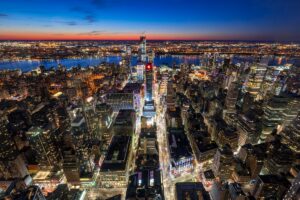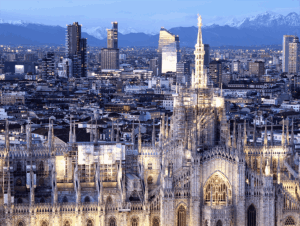A seismic transformation is reshaping New York City’s luxury real estate landscape, with financial titans and tech moguls driving unprecedented demand for downtown Manhattan properties
A striking real estate transaction tells the story of Manhattan’s changing power dynamics. In 2015, a financier and his wife paid $29.1 million for a duplex in the West Village’s prestigious 150 Charles Street. This March, they sold the same unit for $60 million—more than doubling their investment and setting a new downtown Manhattan record.
The buyer’s profile reveals everything about this shift: a senior executive at a quantitative trading firm that recently expanded its Battery Park City headquarters. This transaction represents more than a successful flip—it signals a fundamental realignment of where New York’s wealthiest choose to live and work.
The New Geography of Wealth
For generations, Manhattan’s most expensive real estate clustered uptown along Central Park West, the Upper East Side, and the famed Billionaires’ Row. Today, that monopoly is cracking. Downtown neighborhoods below 14th Street are commanding prices that rival—and sometimes exceed—their uptown counterparts.
The numbers tell a compelling story. Over the past five years, downtown Manhattan has recorded more $30 million-plus home sales than in the entire previous decade, according to industry data. Since 2023 alone, the area has generated over $1 billion in residential transactions exceeding $20 million.
This isn’t merely about isolated luxury purchases. Recent marquee sales include a $41.4 million Tribeca penthouse at 67 Vestry Street in February, and a $49 million unit at West Chelsea’s One High Line last year. A former Credit Suisse executive who purchased a 150 Charles penthouse for $29.38 million in 2016 sold it for $52 million in 2023—an 77% return over seven years.
Corporate Migration Drives Residential Demand
The real estate shift reflects a broader corporate migration. Financial services and technology companies have abandoned Manhattan’s traditional Midtown strongholds for downtown locations, bringing their high-earning employees with them.
Google’s February opening of its newest Manhattan office space at the converted St. John’s Terminal in Hudson Square exemplifies this trend. As one industry expert noted, when one of the world’s wealthiest corporations establishes a significant presence, it fundamentally alters the neighborhood’s profile and resident demographics.
Major lease signings reinforce this pattern. Companies spanning from consulting giant Deloitte to event ticketing platform StubHub have committed to significant downtown footprints near Hudson Yards and the World Trade Center complex. In mid-May, sports merchandising company Fanatics signed a Hudson Square lease—notably, its founder and CEO owns a $43 million penthouse nearby.
Supply Constraints Fuel Price Acceleration
Market dynamics have created a perfect storm for price appreciation. Wealthy buyers face intense competition for limited inventory, particularly in newer condominium developments with large-scale units and luxury amenities.
Current asking prices reflect this scarcity premium. At Aurora Capital’s under-construction 140 Jane Street development in the West Village, a penthouse carries an $87.5 million price tag. Three units have already entered contract for over $40 million since sales launched last year. The velocity speaks volumes: developers report selling units through virtual meetings rather than traditional sales galleries.
Zeckendorf Development’s 80 Clarkson project, strategically located adjacent to Google’s new Hudson Square outpost, initially priced units from $6.755 million for two bedrooms to $63 million for five bedrooms. Since February, the developer has implemented four price increases, culminating in a $75 million full-floor residence released in May.
The development includes premium amenities that rival uptown competitors: a private restaurant, swimming pool, library, and optional wine cellars priced up to $1 million each.
Historic Inventory Shortage
While demand for the area’s historic brownstones remains robust—evidenced by a $72.5 million Greenwich Village townhouse sale in 2024—few renovated properties reach the market. This inventory constraint forces wealthy buyers toward new condominium developments, where units deliver the scale and modern amenities they demand without renovation requirements.
Development limitations compound the supply shortage. Historic district height restrictions and limited available sites mean new downtown buildings typically offer fewer units than Billionaires’ Row towers. This boutique scale intensifies competition among qualified buyers.
Some developments have generated waiting lists that persist years after sellout. Industry professionals report receiving weekly inquiries for units in buildings that have no available inventory, with existing owners commanding premium prices for their reluctance to sell.
The Arms Race for Luxury
New downtown developments are responding to buyer preferences with increasingly sophisticated amenities packages. Projects now feature automated parking systems, private parks, porte-cochères, spas, and concierge services that match or exceed uptown offerings.
This amenities escalation reflects buyer psychology: wealthy purchasers will pay substantial premiums for turnkey luxury rather than undertaking extensive renovations. The preference for new construction over historic properties—regardless of pedigree—has become a defining characteristic of today’s ultra-high-net-worth market.
What This Means for Manhattan’s Future
Manhattan’s downtown transformation represents more than a real estate cycle—it signals a fundamental shift in how New York’s elite live and work. The convergence of corporate relocations, residential preferences, and development patterns is creating a new center of wealth and influence.
For investors and market observers, this trend suggests downtown Manhattan’s luxury market has substantial runway ahead. With supply constraints likely to persist and corporate migration continuing, the area’s transformation from bohemian enclave to billionaire playground appears irreversible.
The implications extend beyond real estate. As financial and technological power concentrates downtown, expect corresponding shifts in cultural institutions, retail concepts, and infrastructure investments that will further cement the area’s status as Manhattan’s new power center.
The bottom line: Manhattan’s wealthy are voting with their wallets, and the verdict is clear—downtown is the new uptown.
Source: Wall Street Journal



